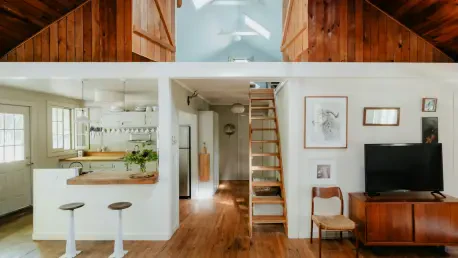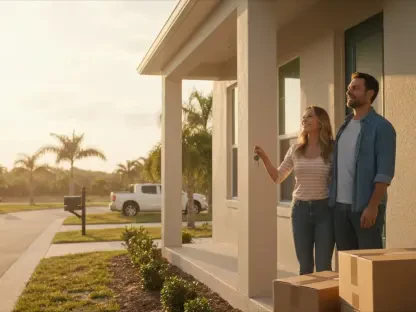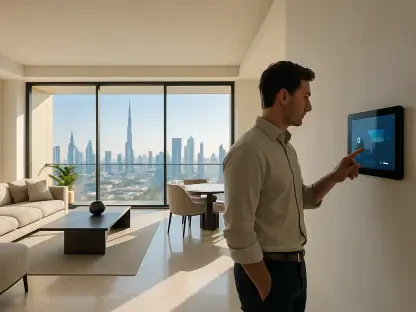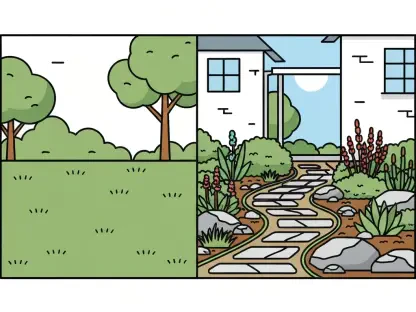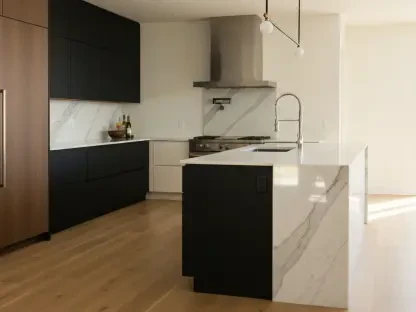The 1990s saw a proliferation of Tuscan farmhouse-style homes which, though beloved in their time, often feel dated by today’s design standards. In Brentwood, Los Angeles, one home originally designed in this style bore witness to this design evolution. As its owners’ family grew and their lifestyle needs shifted, the house, with its classic yet now-outmoded look, presented an opportunity for renewal. Enter Aaha Studio, a design firm known for its innovative approach and led by designers Aaron Leshtz and Harper Halprin. Their mission was clear: to transform the home’s aesthetic while preserving its core character. This transformation not only modernized the house but also beautifully harmonized the original Tuscan elements with a contemporary farmhouse twist.
Transformation Inspiration
Aaha Studio embarked on this architectural journey, driven by inspiration that sought to marry the original charm with modern sensibilities. Under Leshtz and Halprin’s guidance, the transformation began with maintaining the essential farmhouse character while infusing it with an open and airy design. This design philosophy emphasized creating living spaces that cater to both intimate family moments and larger gatherings, aligning with the dynamic lifestyle of the owners. The design team understood the importance of space fluidity and championed a vision of interconnected yet distinct areas, allowing each part of the home to stand on its own while contributing to a cohesive narrative.
The design inspiration was further fueled by a desire to maximize natural light and ventilation. This was critical in transitioning from the previously enclosed, partition-heavy layout to a more open-plan concept. By reimagining the property’s spatial dynamics, the designers sought to blur the lines between indoor and outdoor living. The impetus was not just aesthetic but also functional, aiming to enhance how each space is used. This transformation was about more than just looks; it was rooted in improving quality of life for the homeowners and ensuring that both the daily routine and special occasions could be effortlessly accommodated.
Key Design Elements
Central to this ambitious renovation was the seamless integration of form and function, ensuring each design decision enhanced both style and livability. A significant focus was placed on minimizing clutter and maximizing openness, prompting the removal of several outdated elements that characterized the home’s original construction. The design process involved strategically removing partition walls to create a flowing transition between rooms, effectively merging spaces without sacrificing their individual purposes. This architectural strategy allowed for a more adaptable environment catering to the growing family’s needs.
A standout alteration was the repositioning of the kitchen—a once cramped and dimly lit area—transforming it into a bright, spacious hub of the home. As a gathering place, the kitchen now serves as a microcosm of the home’s overall design philosophy: open, warm, and inviting. The integration of the kitchen into the broader living space reflects a growing trend where culinary areas are not hidden away but celebrated as central to the home’s social fabric. This approach underscored the new design direction, where spaces are designed not just to be inhabited but enjoyed, strengthening the connection between the home’s inhabitants and their environment.
Natural Materials and Neutral Tones
The transformation leaned heavily on the hallmark features of modern farmhouse aesthetics: natural materials and a palette of neutral tones. This design choice not only updated the home’s appearance but also brought a sense of warmth and approachability. A recurrent theme was the substantial use of wood, which offered a tactility and depth that synthetics simply cannot match. Whether in the form of oak cabinets or intricate millwork, wood became the backbone of the home’s new identity, providing a unifying feature throughout the different spaces.
Complementing the wood’s warmth were white and black tones, strategically used to set a chic yet understated backdrop. These neutral tones allowed the architectural and design features to stand out without overwhelming the senses. By employing this color scheme, the design maintained a balance between boldness and subtlety, ensuring that no element overshadowed another. The thoughtful use of custom millwork and centerpieces like kitchen islands served as functional art, catching the eye while serving everyday utility. This approach encapsulated the ethos of modern farmhouse design: striking a balance between elegance and practicality while fostering a cohesive, inviting atmosphere.
Structural Enhancements
To further elevate the home’s design, strategic structural enhancements played a pivotal role in enhancing aesthetics and usability. One of the foremost modifications was the installation of larger windows and skylights, designed to flood the interiors with natural light and enhance the connection to the outdoors. This structural adjustment not only brightened the interiors but also emphasized the ongoing theme of openness, allowing the beauty of the home’s surroundings to augment its interior charm.
Another critical change involved the incorporation of large-format pocketing doors. These doors offered a seamless transition between interior spaces and the exterior patio area, effectively extending the living space beyond its traditional boundaries. This change resonated with the home’s original aesthetic intentions of fostering an indoor-outdoor lifestyle but brought them into a contemporary context. Such enhancements resonate with a trending desire for homes that maximize both enjoyment and functionality of space, reflecting modern preferences for design elements that serve dual purposes.
Renovation Trends
In recent years, there has been a noticeable trend towards renovating older homes, bridging the gap between traditional charm and modern conveniences. This trend is fueled by a growing recognition that stylish spaces need not compromise on practicality. The work done by Aaha Studio serves as an exemplar of how intelligent and intuitive design can rejuvenate properties, maintaining their historical significance while aligning them with current living standards. This movement towards renovating rather than rebuilding underscores a more sustainable approach to architecture, emphasizing renewed usage over disposal and replacement.
Through this transformation, the project highlighted how careful design choices could breathe new life into such properties. The emphasis on marrying time-tested elements with contemporary innovations reflects a broader industry recognition of the value in such renovations. This case study demonstrates how with thoughtful planning and creative execution, older homes can not only regain their relevance but also set new standards in design and functionality. Such projects ensure these homes remain livable and vibrant for future generations, adapting to new societal norms and technological advances without erasing their histories.
Modern Farmhouse Aesthetic
The 1990s introduced a widespread admiration for Tuscan farmhouse-style homes, characterized by their rustic charm. However, as time has passed, many of these homes appear dated compared to current design preferences. In the upscale neighborhood of Brentwood, Los Angeles, one such home originally built in this style was ready for a modern makeover as its owners required more space and functionality due to a growing family. This situation offered a perfect chance to breathe new life into the home. Aaha Studio, renowned for its creative design solutions and led by designers Aaron Leshtz and Harper Halprin, accepted the challenge. Their objective was to revamp the home’s aesthetic while maintaining its intrinsic essence. They successfully modernized the residence while creating a seamless blend of classic Tuscan features with a contemporary farmhouse style, ensuring the home met current design expectations while respecting its original architectural identity.
